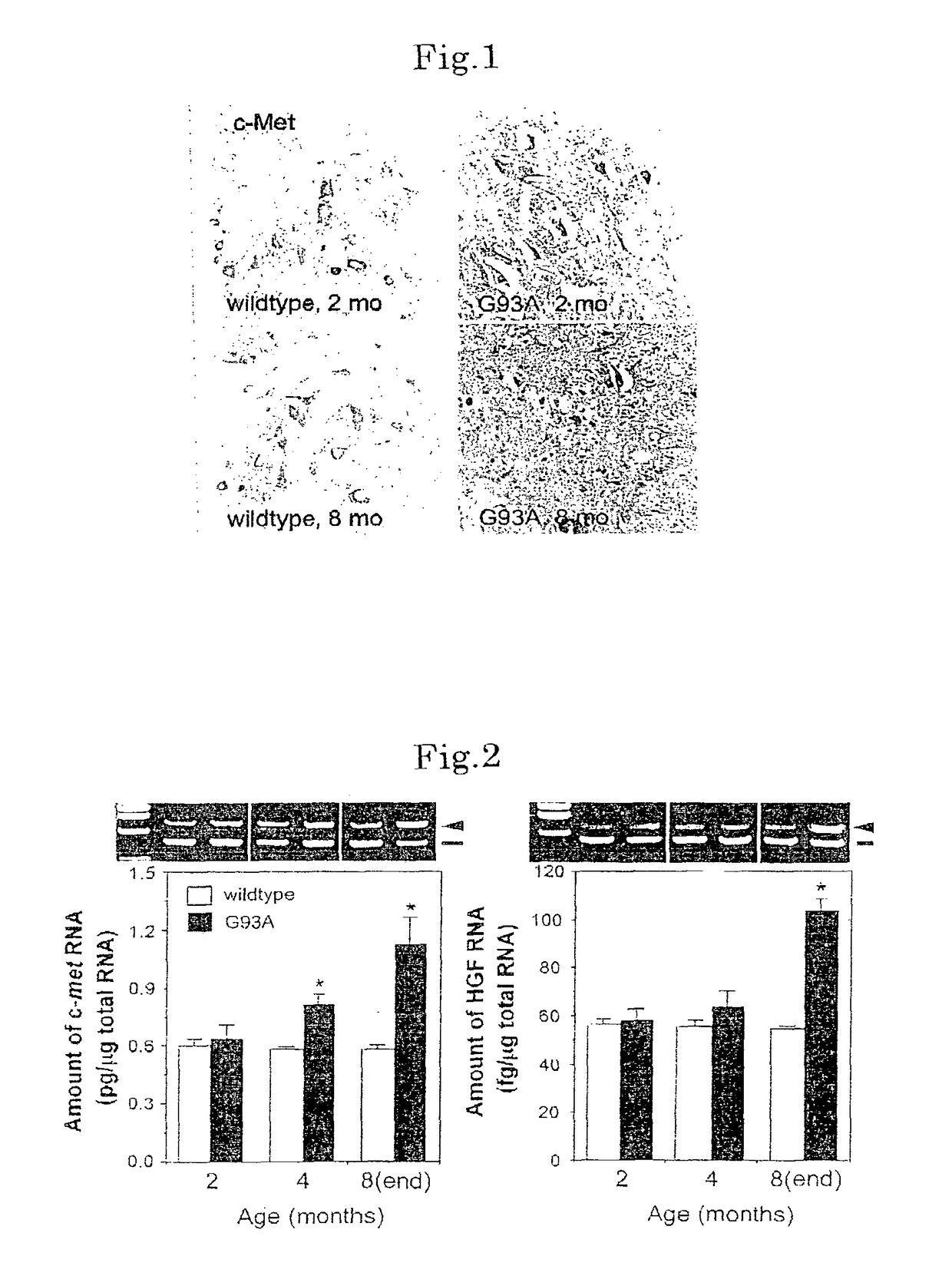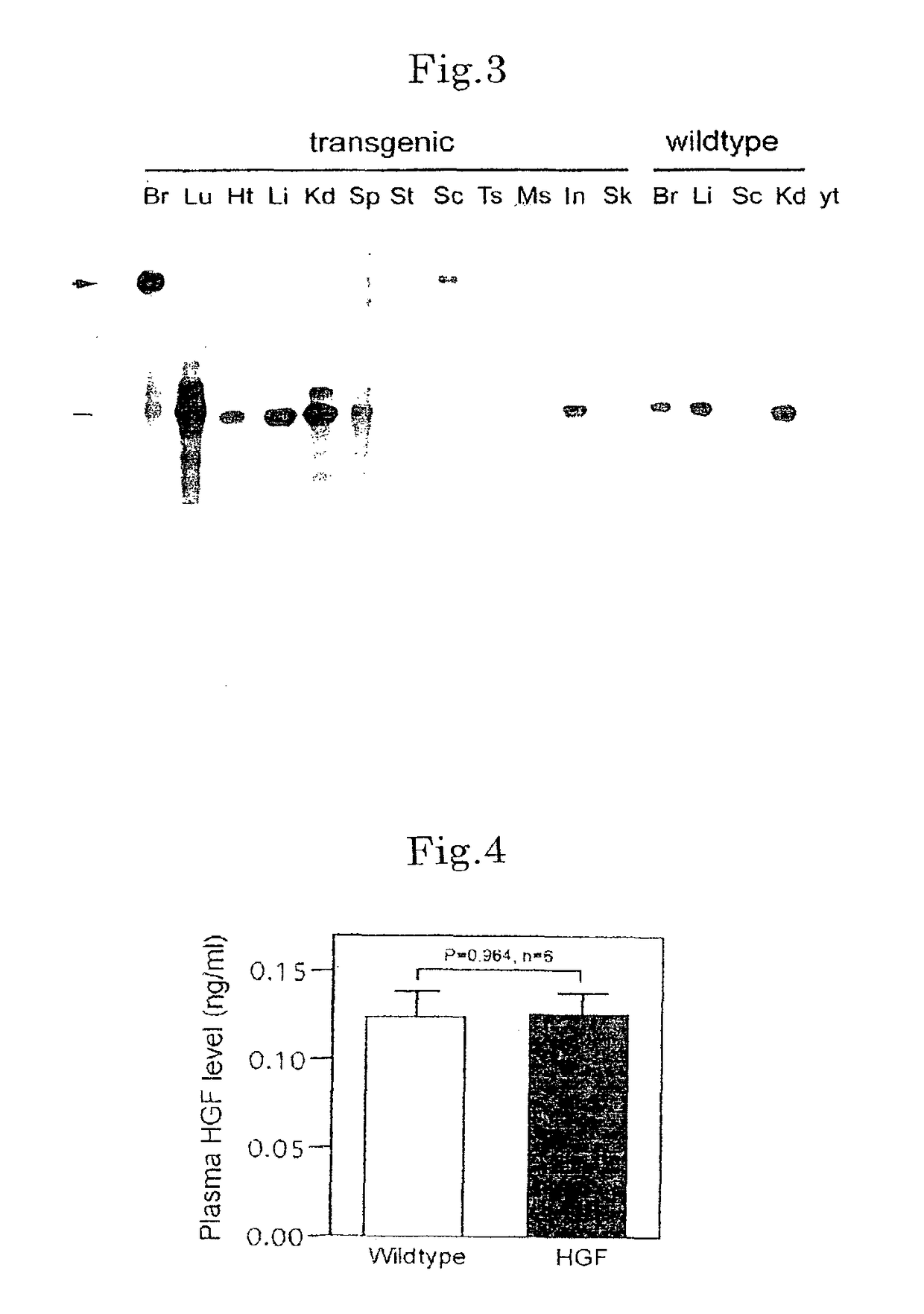Methods of treating amyotrophic lateral sclerosis by HGF
a technology hgf, which is applied in the field of amyotrophic lateral sclerosis treatment (als), can solve the problems of motor dysfunction and shortening the life span, and inability to meet the needs of patients,
- Summary
- Abstract
- Description
- Claims
- Application Information
AI Technical Summary
Benefits of technology
Problems solved by technology
Method used
Image
Examples
example 1
Expression and Regulation of HGF and c-Met in G93A Transgenic Mice
[0098]In motoneurons of G93A transgenic mice, it was studied by immunohistological analysis to observe presence or absence of c-Met / HGF receptor-like immunoreactivity (c-Met-IR). As a result, same as in motoneurons of wildtype littermates, localization of c-Met-IR was discovered in motoneurons of 2-month-old G93A mice (FIG. 1). At 8 months when G93A mice were at endstage, c-Met-IR was observed in many cells in the ventral horn, and the wildtype littermates of same age indicated a same level of c-Met-IR as those of 2 months of age (FIG. 1).
[0099]Quantification of HGF and c-met mRNA in the ventral horn of spinal cord in the progressive stage of G93A transgenic mice was determined by the competitive RT-PCR, and compared with that of wildtype mice of the same age. As a result, the expression level of c-met and HGF mRNA in the ventral horn of the spinal cord in which motoneurons localize is known to increase progressively ...
example 2
Preparation and Characterization of Transgenic Mice Excessively Expressing HGF Neuron-specifically
[0100]To study the effect of HGF in ALS, transgenic mice expressing rat HGF neuron-specifically were prepared by using neuron-specific enolase promoter (NSE). From eight independent lines of HGF transgenic mice, one line expressing the exogenous HGF specifically at relatively low level specifically in the nervous system was selected. FIG. 3, FIG. 4 and FIG. 5 show the characteristics of the HGF transgenic mouse lines. By RNase protection assay, exogenous HGF was known to be expressed in the brain and spinal cord specifically among 12 tissues being tested (arrow in FIG. 3). Among tissues of HGF transgenic mice, the endogenous and whole HGF levels in the plasma were not different from the levels in the wildtype littermates (FIG. 3 and FIG. 4). On the other hand, the level of HGF protein increased along with the growth of mice in the spinal cord, only after termination of principal differe...
example 3
Investigation of Effect of HGF on ALS (1)
[0102]To study the role of HGF on ALS, heterozygotes (+ / −) of HGF transgenic mice were mated with heterozygotes (+ / −) of G93A mice, and transgenic mice having HGF introduced directly into ALS neurons were prepared. By this mating, four different groups of mice were created, that is, wildtype (W), transgenic to HGF only (HGF), transgenic to G93A only (G93A), and double transgenic to both G93A and HGF (G93A / HGF).
[0103]First of all, it was histologically analyzed to see if expression of HGF would trigger neuroprotective action on motoneurons. Results are shown in FIG. 6 and FIG. 7. Paraffin segments (14 m) of the ventral horn of lumbar spinal cord at endstage stained by crystal violet were evidently decreased in the number of motoneurons of G93A mice (G93A), and the remaining motoneurons were atrophied (FIG. 6). On the other hand, double transgenic littermates (G93A / HGF) maintained spinal cord motoneurons having many healthy forms evidently as c...
PUM
| Property | Measurement | Unit |
|---|---|---|
| body weight | aaaaa | aaaaa |
| body weight | aaaaa | aaaaa |
| body weight | aaaaa | aaaaa |
Abstract
Description
Claims
Application Information
 Login to View More
Login to View More - R&D
- Intellectual Property
- Life Sciences
- Materials
- Tech Scout
- Unparalleled Data Quality
- Higher Quality Content
- 60% Fewer Hallucinations
Browse by: Latest US Patents, China's latest patents, Technical Efficacy Thesaurus, Application Domain, Technology Topic, Popular Technical Reports.
© 2025 PatSnap. All rights reserved.Legal|Privacy policy|Modern Slavery Act Transparency Statement|Sitemap|About US| Contact US: help@patsnap.com



